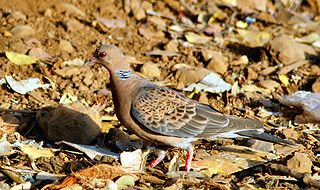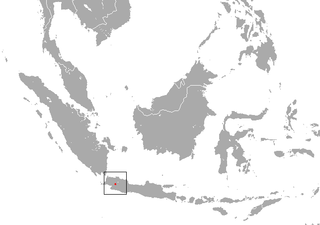
The mouflon is a subspecies group of the wild sheep. Populations of O. orientalis can be partitioned into the mouflons and the urials. The mouflon is thought to be the ancestor for all modern domestic sheep breeds.

The oriental turtle dove or rufous turtle dove is a member of the bird family Columbidae. The species has a wide native distribution range from Europe, east across Asia to Japan. The populations show variations in the patterning of plumage and have been designated into at least six named subspecies. Populations in the higher latitudes tend to migrate south in winter while those closer to the tropics are sedentary. Vagrants have been recorded in North America. The species is predominantly granivorous and forages on the ground.

Platycladus is a distinct genus of evergreen coniferous tree in the cypress family Cupressaceae, containing only one species, Platycladus orientalis, also known as Chinese thuja, Oriental arborvitae, Chinese arborvitae, biota or oriental thuja. It is native to northeastern parts of eastern Asia and north Asia, but is also now naturalised as an introduced species elsewhere in Asia.

The urial, also known as the arkars or shapo, is a subspecies group of the wild sheep Ovis orientalis. Noticeable features are the reddish-brown long fur that fades during winter; males are characterized by a black ruff stretching from the neck to the chest and large horns. It is found in western central Asia. The other subspecies group of O. orientalis is the mouflon. The two groups have often been considered separate species.

Thenus orientalis is a species of slipper lobster from the Indian and Pacific oceans.

The Oriental shrew is a species of mammal in the family Soricidae. It is endemic to Indonesia. It is threatened by habitat loss.

The Javan ferret-badger is a mustelid endemic to Java and Bali, Indonesia. It is listed as Least Concern on the IUCN Red List and occurs from at least 260 to 2,230 m elevation in or close to forested areas.

Trema orientalis is a species of flowering tree in the hemp family, Ulmaceae. It is known by many common names, including charcoal-tree, Indian charcoal-tree, pigeon wood, Oriental trema, and in Hawaii, where it has become naturalized, gunpowder tree, or nalita. It has a near universal distribution in tropical and warm temperate parts of the Old World, with a range extending from South Africa, through the Middle East, the Indian subcontinent and southern China to Southeast Asia and Australia.
Orientalis ecclesiae is an encyclical of Pope Pius XII. Its topic is St. Cyril, Patriarch of Alexandria.

The eastern carrion crow is a member of the crow family and a subspecies of the carrion crow. Differences from the nominate subspecies include a larger size, at a length about 500 millimetres (20 in), and more graduated outer tail feathers. The eastern carrion crow is found in Siberia from the Yenisei to Japan, south to Central Asia, Afghanistan, Eastern Iran, Kashmir, Tibet and northern China. They generally lay three to five eggs in trees or buildings. The eggs show no difference from the nominate subspecies.
Phrissomini is a tribe of longhorn beetles of the Lamiinae subfamily. It was described by Thomson in 1860.
Paravelleda is a genus of longhorn beetles of the subfamily Lamiinae, containing the following species:
Paravelleda grisescens is a species of beetle in the family Cerambycidae. It was described by Stephan von Breuning in 1949.
Paravelleda kenyensis is a species of beetle in the family Cerambycidae. It was described by Stephan von Breuning in 1936.
Paravelleda nyassana is a species of beetle in the family Cerambycidae. It was described by Stephan von Breuning in 1936.
Paravelleda pulchra is a species of beetle in the family Cerambycidae. It was described by Stephan von Breuning in 1938.
Paravelleda aberrans is a species of beetle in the family Cerambycidae. It was described by Duvivier in 1891.
Paravelleda bispinosa is a species of beetle in the family Cerambycidae. It was described by Per Olof Christopher Aurivillius in 1910.
Paravelleda dentata is a species of beetle in the family Cerambycidae. It was described by Hintz in 1911.
Paravelleda gedeensis is a species of beetle in the family Cerambycidae. It was described by Adlbauer in 2010. It is known from Kenya.










